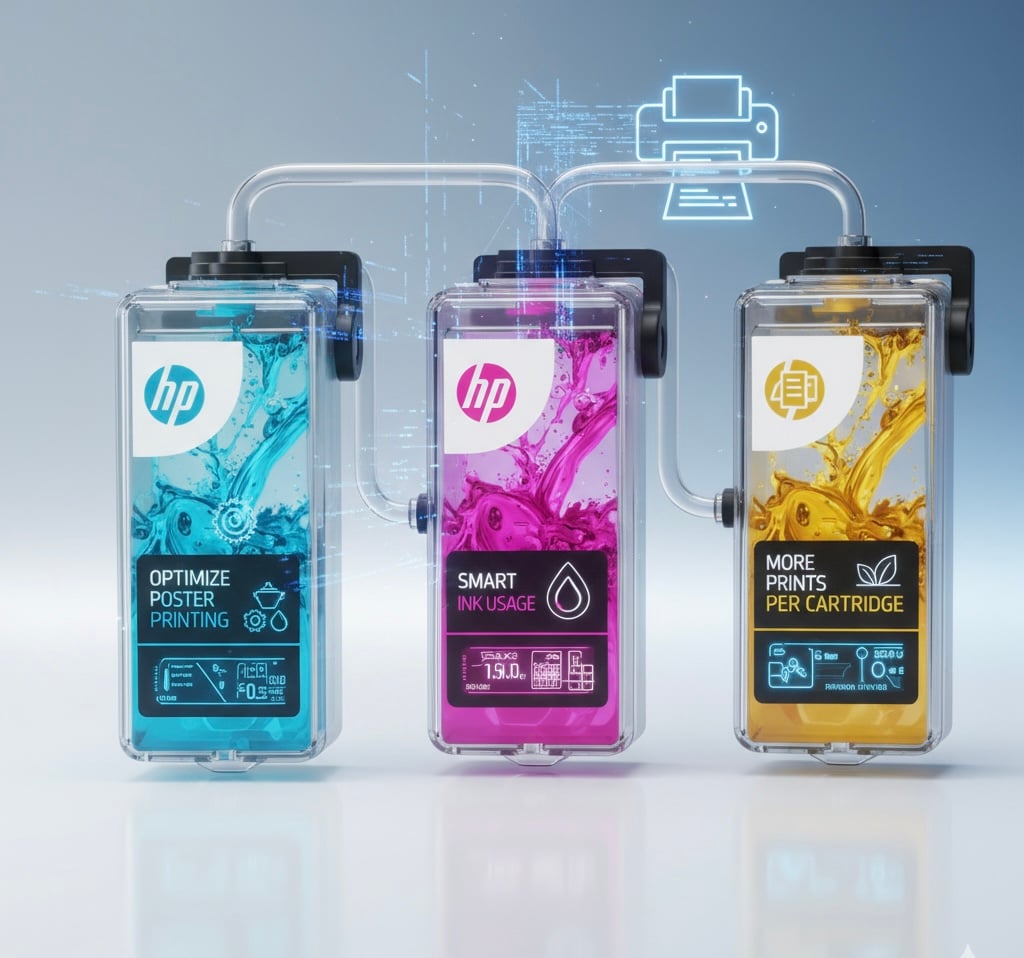
DISCOUNTED EDUCATION PRICING! CALL 1-877-891-8411. We Gladly Accept School Purchase Orders!

Poster printing is a powerful way to create vibrant marketing materials, art prints, or event signage, but poster printer ink costs can quickly add up. Whether you’re a small business owner, a graphic designer, or a hobbyist, optimizing ink usage can save you money, reduce waste, and maintain professional-quality results. This comprehensive guide shares seven expert hacks to help you get the most out of your poster printer ink in 2025. Each hack is paired with practical tips, real-world examples, and answers to common questions to ensure you can apply these strategies effectively.
Poster printer ink cartridges for large-format poster printers are a significant expense, often costing $50 to $200 each, depending on the printer model and brand. Frequent printing can drain your budget and increase environmental waste from discarded cartridges. By optimizing ink usage, you can:
Key Tip:
Small changes, like adjusting print settings or redesigning files, can reduce ink consumption by up to 30% while keeping your posters sharp and vibrant.
Let’s dive into the seven hacks, complete with actionable steps and examples to help you save ink and money.
Print resolution, measured in dots per inch (DPI), controls the detail in your posters. Higher DPI (e.g., 1200) produces sharper images but uses more ink. For many posters, especially those viewed from a distance, lower DPI settings (e.g., 300–600) deliver excellent quality with less poster printer ink.
A local print shop producing 24×36-inch event posters switched from 1200 DPI to 300 DPI for outdoor signage. This reduced ink usage by 25%, saving $180 monthly on cartridges without compromising visual appeal.
Quick Tip:
Test DPI settings by printing a small sample. For posters viewed from 10 feet away, 150–300 DPI often looks as good as 1200 DPI, saving up to 25% on poster maker ink.
Draft mode (or economy mode) is a low-ink setting on most poster printers, ideal for test prints or proofs. It reduces ink output by printing lighter images, saving resources during the design phase.
A freelance designer used draft mode to proof 50 event posters, cutting ink usage by 20% per print. This allowed them to test multiple layouts without exhausting their Canon imagePROGRAF’s pigment-based ink.
Quick Tip:
Draft mode can save 20% on ink for test prints. Use it for internal proofs to preserve ink for final, client-ready posters.
Software like Adobe Photoshop, Illustrator, or Canva can help create ink-efficient poster designs. By optimizing colors, reducing heavy ink elements, and choosing the right file formats, you can significantly cut ink consumption.
A marketing team redesigned their posters to use 50% less black ink by incorporating gray gradients instead of solid backgrounds. This saved $250 annually on ink for their Epson SureColor printer.
Quick Tip:
Avoid solid black backgrounds and export files as compressed JPEGs or PDFs to save up to 50% on ink while maintaining professional designs.
Clogged printheads or misaligned printers can waste ink through excessive cleaning cycles or uneven application. Regular maintenance ensures efficient ink delivery and consistent print quality.
A print studio performing weekly maintenance on their HP Latex printer reduced cleaning cycles by 40%, saving $120 monthly on ink waste.
Quick Tip:
Calibrate your printer monthly and store cartridges in a cool, dry place to cut cleaning cycle ink waste by up to 40%.
Poster printers use various inks, each suited to specific needs:
An artist switched to pigment-based inks for gallery posters, reducing reprints due to fading and saving $350 annually despite higher initial costs.
Quick Tip:
Match ink to your poster’s purpose: dye-based for temporary prints, pigment-based for durability. Third-party inks can save 20–50% if compatible.
Printing multiple posters in one session minimizes ink waste from printhead priming and cleaning cycles, which occur at the start of each print job. It also ensures consistent ink flow.
A small business batched their weekly poster prints, cutting startup ink waste by 15% and saving $150 annually on their Roland VersaUV printer.
Quick Tip:
Batch print similar posters to reduce startup waste, saving up to 15% on ink by minimizing cleaning cycles.
Modern poster printers and software offer tools to monitor ink usage, predict cartridge life, and identify inefficiencies, helping you avoid waste and unexpected shortages.
A print shop used Canon’s Printer Management app to monitor ink levels, avoiding over-ordering and saving $250 annually by optimizing cartridge purchases.
Quick Tip:
Use printer apps or tools like PrintFab to track ink levels and set alerts, saving up to $250 annually by avoiding waste.
Third-party inks can save 20–50% compared to OEM inks, but quality varies. Research compatibility and user reviews to avoid clogs or color issues. A 2025 X post from a printing community noted 30% savings with compatible Epson poster printer inks, with minimal quality differences.
Run manual cleaning cycles only when you notice print issues like streaks or missing colors. Overuse can waste 5–10% of your ink. Weekly printhead checks can prevent the need for frequent cycles.
For high-volume printing, RIP software saves 10–20% on poster printer ink by optimizing layouts. For small-scale users, free tools like GIMP or printer-native software can achieve similar results.
Print test samples at 150, 300, and 600 DPI. If a lower DPI looks comparable at the intended viewing distance, use it to save ink without sacrificing quality.
Optimizing your poster printer ink usage is a practical way to save money, reduce environmental waste, and produce stunning prints. By fine-tuning resolution, using draft mode, designing efficiently, maintaining your printer, choosing the right ink, batch printing, and tracking usage, you can extend cartridge life by up to 30%. These expert hacks, supported by real-world examples, empower you to print smarter in 2025.
For more tips or to connect with other printers, explore communities on X or visit x.ai/grok for additional resources. Start applying these strategies today to keep your costs low and your posters vibrant!